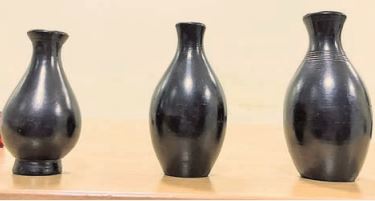Rourkela: Researchers from National Institute of Technology (NIT), Rourkela have patented an eco-friendly method to produce black terracotta wares, according to officials.
The research team, led by Swadesh Kumar Pratihar, Professor of Ceramic Engineering, along with Shiv Kumar Verma, senior technical assistant, and Rupesh Mandal, a research graduate from NIT-Rourkela, has developed the process, which merges traditional artisan knowledge with modern technology to produce black terracotta sustainably.
The word terracotta comes from Italian and means “baked earth”. In India, it has been extensively used for kitchenware, temple sculptures and roofing tiles. The most common variety is red terracotta, made by firing clay in the presence of air. According to Pratihar, the presence of iron in the clay, when exposed to fire, leads to oxidation, resulting in its characteristic red colour. In chemical terms, ferric oxide produces the red colour in the process.
Also Read: NIT Rourkela’s smart hybrid microgrid to ensure green energy supply in rural areas
On the other hand, black terracotta wares are known for their contrasting shine and mirror finish. Black pottery is made in India and its neighbouring regions using techniques that are generations old. One such example is the Nizamabad Black Pottery of Uttar Pradesh, where semi-finished wares are coated with a glaze made of clay and organic vegetable matter native to the area, referred to as “kabiz”. Polishing with mustard oil gives the surface a mirror finish. It is then fired in a sealed iron vessel along with cow dung, straw and wood chips.
Crafting beautiful black ware requires time, effort, constant monitoring, specialised clay, skilled hands and organic fuel in solid form. In Tibet’s Nixi village, artisans use coarse red clay mixed with white sand and powdered black baked quartz. The wares are covered with wood logs during firing, and once the desired temperature is reached, the fire is extinguished using sawdust. The smoke produced in this final step turns the pottery black.
“The existing production method typically requires two days to complete the open-pit firing process, which releases smoke containing many toxic gases, such as carbon monoxide, carbon dioxide, sulfur oxides and nitrogen oxides, that adversely affect the health of associated workers, including breathing difficulties,” Pratihar said.
“With the aim of eliminating the major drawbacks of these generation-old processes and focusing on sustainable development, the patented method developed by us reduces the total firing process to less than seven hours without any adverse impact on the health of working associates and the climate,” Pratihar said.
The researchers explained that the key to this process is the indirect heating of as-fabricated bodies in an enclosed vacuum (air-depleted) chamber.
Orissa POST – Odisha’s No.1 English Daily
